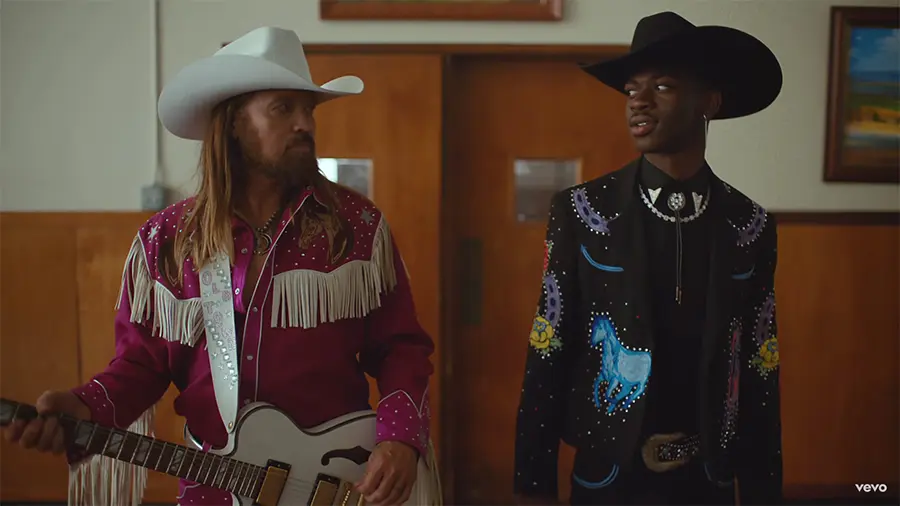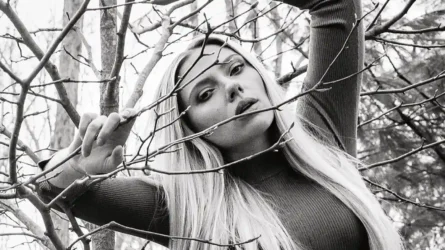Old Town Road
Explore how music videos can communicate important cultural meanings in our detailed guide to Lil Nas X’s debut single.
Introduction
Montero Lamar Hill was living in his sister’s house in Atlanta when he bought a track for $30 on Beat Stars and scribbled down some meme-worthy lyrics. He uploaded “Old Town Road” in December 2018 and spent the next few months using different social media channels to promote the song. After millions of streams, yeehaw memes, countless awards, and a record-breaking nineteen weeks at the top of the American charts, Lil Nas X became “an internationally recognized phenomenon”.
We are going to explore the cultural and economic context behind the musician’s rise to power and analyse the music video’s representations of race and gender. Hopefully, we can gain a deeper appreciation and understanding of how media texts construct meaning and communicate important ideologies to the audience.
Contents
The Official Movie
Different versions of the music video are available, but our focus is on the “Official Movie” which was released in May 2019. Directed by the American filmmaker Calmatic, the remix featured Billy Ray Cyrus with guest appearances from Chris Rock as the sheriff and his flabbergasted deputy HaHa Davis. Keep an eye out for Young Kio as the stunned mechanic.
Genre
Steve Neale (1980) believed films were “signifying processes” full of “meanings and positions”. Filmmakers are able to encode messages through the “interplay” of dialogue, gestures, costumes, sets, lighting techniques, camera shots and movement, non-diegetic sound, editing, and many other important elements.
Genres are specific combinations of codes being reused and reworked into lots of films.
For example, westerns normally follow the stories of drifters, cowboys, and outlaws struggling to survive in the desolate and cruel deserts of America’s “Wild West” in the 19th century. Armed with revolvers and wearing their Stetson hats, the protagonists often connoted social order and power over nature. Inevitably, the narrative ended with a duel between quick-drawing gunslingers – a battle between good and evil.
Audiences also expect certain technical codes: slow cuts between dramatic long shots and close ups of intense stares, high-key lighting of exterior shots, and guitar strings punctuating the scenes.
“Old Town Road” repeats well-worn genre tropes, but Lil Nas X plays with the conventions to create his own vision.
We will return to the western genre in our analysis of the video’s narrative and representation, but it might be more appropriate to begin with a look at the controversy surrounding the song’s classification and then consider the broader definitions of music video categories.
Musical Genres
When Lil Nas X uploaded the original track to SoundCloud, he selected “country” from the list of genres available in the drop-down menu. These tags can help musicians connect with users who are interested in discovering the latest tunes in a particular genre. In fact, “Old Town Road” remains the most popular country music song on SoundCloud.

Importantly, if anyone streamed or bought a digital copy of the track, it added to the position of “Old Town Road” in the platform’s country charts. The song became so popular online it reached number 19 on Billboard’s Hot Country Songs chart before being disqualified because the magazine decided the song did not actually fit the genre. In a statement to Rolling Stone Magazine, they said: “While Old Town Road incorporates references to country and cowboy imagery, it does not embrace enough elements of today’s country music”.
Lil Nas X does rap about the “old town”, the harsh and dangerous “valley”, horse riding, bull riding, cowboy hat and jeans. There is the inevitable reference to a broken relationship with the lines “cheated on my baby” and “you can go and ask her”. Some of these signifiers are echoed by the visuals in the music video.
There is a tremendous sense of defiance and a wonderful spirit of independence in the chorus: “I’m gonna take my horse to the old town road / I’m gonna ride ’til I can’t no more”. Nothing is going to stop the speaker from fulfilling their dreams. These themes of loss and liberty are typical of the country music genre.
Of course, Lil Nas X is reworking their meanings into something new. This change is epitomised by the use of the word “rodeo” which traditionally denotes a competition with cattle and horses. However, in “Old Town Road”, the same word carries connotations of wealth because it now refers to Rodeo Drive in Beverly Hills – a place famous for its luxury shops.
By the way, Billboard has to make these sorts of judgments every week for all its genre charts and “Old Town Road” did top the list of their Hot R&B/Hip-Hop Songs in March 2019.
Although Lil Nas X submitted the song for consideration in rap categories at the Grammy Awards, the Billy Ray Cyrus remix was placed into the pop category where it won the award for Best Pop Duo/Group. The song does contain many of the typical characteristics of pop music, such as the blurring of genres, easy tone of the lyrics, the simple structure, consistent rhythm, repeated chorus, and memorable hooks.
In an interview with Time Magazine, Lil Nas X defined the song as country trap – a fusion country music and rap. He also said it should have appeared on both the country and rap charts.
Creators and critics have always tried to make connections between style, theme, plot, and subject content in an attempt to classify media texts. However, Steve Neale also argued genres only appear to be “clearly defined systems”. This is especially true when artists begin to mix and reshape the elements that define the category.
Is “Old Town Road” country, rap, hip-hop, pop, or the hybrid country trap?
Perhaps it was a commercial decision rather than one based solely on musical form. Lil Nas X knew the hip-hop tag was much more competitive, so he opted for country because there was a greater chance of attracting attention and getting those essential likes, shares and reposts he needed to get the song trending.
Music Videos
Music videos are effective marketing devices used to promote an artist or group. Creating a visual representation of the musicians and their music can help raise their profiles, establish their values and beliefs, and deepen their connection with the target audience. They can also be great fun.
In terms of music video genre, “Old Town Road” is a hybrid because it mixes conventions from both performance and narrative modes.
Performance Mode
Most videos consist of footage of the artist(s) performing their song, usually with some direct address to the audience, such as singing on stage in front of a live audience. This visibility reinforces their identity and emphasises their skills as musicians.
The following screenshot is from the second verse when Lil Nas X is racing on his horse against the car. He delivers the line “Wrangler on my booty” while looking straight at the camera.

Matching the tone of lyrics, the shot is quite comical: the use of a slow-motion effect with the lip sync maintained, non-verbal codes, such as his facial expression, the image of the tractor in the background, and the fact he supposedly on a horse. In terms of representation, Lil Nas X’s dress codes are strongly associated with a rugged masculine identity – the cowboy. The gold cross earring draws attention to his Christian background. Of course, the artist is playing with these signifiers to construct his own identity.
Lil Nas X also delivers the chorus on stage in the community hall. His movement, especially the expressive outstretched hand, the impassioned singing, and the microphone all remind the audience that he is a performer who we should see live on stage.

Narrative Mode
Lots of artists construct a story to strengthen the audience’s engagement with the music. The visuals might influence how we decode the lyrics, position us to take a particular attitude towards an issue, or communicate the artists’ personality.
The story in “Old Town Road” begins with our protagonists being chased by the sheriff and his deputies. Managing to escape with their bags of cash, they take refuge on an isolated farm. In terms of Tzvetan Todorov’s narrative theory, this dangerous routine is the equilibrium.
When the landowner shoots at the outlaws for trespassing on his property, Lil Nas X dives into a mine only to warp from Old Town Road in 1889 to its equivalent in 2019. Our hero then has to compete in the modern world to repair the disequilibrium. Finally, he establishes a new equilibrium when he wins the hearts, minds, and dancing shoes of the bingo players.

After Lil Nas X wins the street race against the rapper Vince Staples, he spends the money on a flamboyant outfit. In his research of Russian folk tales, Vladimir Propp noted the heroes were often given new clothes to recognise their triumph over evil and their new status in society. The theorist called this the transfiguration. The change in dress codes, from the traditional leather to more contemporary fabrics and designs in “Old Town Road”, connotes the musician’s transformation.
It is clear from the story arc we are being positioned to admire Lil Nas X and view him as the hero of the tale.
Red Dead Redemption 2
In the first video for “Old Town Road”, Lil Nas X used footage from the popular computer game “Red Dead Redemption 2” to promote his song. Set in an open world in 1899, you take control of the outlaw Arthur Morgan to “rob, steal and fight” your way across “the rugged heartland of America to survive”.

Henry Jenkins (1992) used the phrase textual poaching to describe the process of reworking the “semiotic raw materials” of media products to create something new. The western themes obviously suited Lil Nas X’s lyrics and the mashup was an incredible success, racking up at least 1 million views on YouTube.
Lil Nas X had not been signed by Columbia Records at this point, so it is also worth noting Clay Shirky’s concept of mass amateurisation. It refers to our ability to use technology to compete with professional media producers. Lil Nas X simply recorded the gameplay on his console and then created a really engaging montage to match his song.
Although the rapper deleted the original upload from YouTube, you can still watch plenty of other fan made edits to get a sense of what he created and why it appealed to the gamers.
Codes and Conventions of Westerns
The codes and conventions of westerns are so firmly established in our culture even someone unfamiliar with the classic films will recognise the genre’s tropes in “Old Town Road”. There must be an important symbolic meaning encoded in the images and narratives that appeals to mass audiences.
Perhaps it’s the freedom of the wild and open country where men are able to escape the restraints and demands of the urban world. Or the representation of the hero battling against evil encouraging the viewer to be tough and courageous in their own conflicts. In a piece for Genius, Lil Nas X said he was the “runaway, loner cowboy” who wasn’t going back to work and the chorus emphasised the need for “perseverance”.
Researching the popularity of westerns and why the genre appealed to audiences, Will Wright (1975) identified the common plot points used in the biggest box office successes. Classic narratives begin when “the hero enters a social group”. They are “unknown to the society” but the stranger’s “exceptional ability” is soon recognised and the “hero is given a special status”.
It is the story of the lone stranger who rides into a troubled town and cleans it up, winning the respect of the townsfolk and the love of the schoolmarm.
Will Wright
The residents are absolutely stunned when Lil Nas X enters Old Town Road on his horse. For example, the mechanic’s assistant is dazed by the unusual sight:

Lil Nas X’s position as the outsider is epitomised by the reaction of the locals playing bingo in the community hall. However, when he performs on stage, his “exceptional ability” gets everyone dancing and he is “given a special status”.
Classical western narratives then focus on the conflict between the hero and villain. You could argue the villain in “Old Town Road” is xenophobia – Lil Nas X defeats the evil, and “society accepts the hero”.
Describing a slightly different type of western, the professional narrative, Wright referred to the hero forming a group with a “sense of unity, respect, and friendship” to fight against the villain. Lil Nas X and Billy Ray Cyrus do join forces in “Old Town Road” and conquer the new frontier.
By analysing the “structure of a myth”, such as westerns and other popular forms, Wright believed we can “discover its social meaning”. So, what messages does “Old Town Road” communicate to the audience? We need to explore the representations of gender and race.
Representation of Masculinity
Heroes test their masculinity in classical westerns by crossing the primeval landscape, surviving the relentless heat of the sun, and bringing order to the wild frontier. They remain stoic and resolute throughout the story. We have already seen how Lil Nas X performs aspects of this masculine identity in the music video, but his playful interpretation reminds the audience that gender roles are social constructs.
Liesbet van Zoonen (1996) believed gender roles seemed “natural” because they were always being reinforced in society. She argued feminist discourse defined masculinity by its sense of “competition, individualism, ruthlessness”. Westerns certainly reinforced this identity and there is a combative quality to many of the lines in “Old Town Road”, including “I been in the valley, you ain’t been off that porch”.
Each depiction of an active and aggressive masculinity identity is yet another signal to the male audience that they too need to be active and aggressive. Billy Ray Cyrus even defends his masculine virtues by referring to the Marlboro Man – a character who was supposed to represent a “real” American man.
Judith Butler (1999) called this process performativity. They also argued gender is not a stable signifier but is “open to intervention and resignification”. However, any representations outside the traditional binary challenged the dominant ideology and caused gender trouble.
The reaction to Lil Nas X’s announcement that he was gay seems to prove Butler’s point. There were many messages of support, but the rapper also experienced a backlash on social media. In the BBC interview, he said he understood homosexuality was “not really accepted in either the country, hip-hop communities”. Speaking to Time magazine, he commented: “people who listen the most” to his song were probably “not accepting of homosexuality”.
It was only in 2015 when a ruling by the Supreme Court struck down all state bans on same-sex marriages that marriage equality was finally recognised everywhere in America. It seems some aspects of the music industry continue to resist change and broader definitions of masculinity.

Race and Old Town Road
Musical genres have always been linked to race in America.
Billboard magazine published a “Race Records” chart in 1945 to list the Black musicians who “sold best” from a “selected group of retail stores”. The name changed to “Rhythm & Blues Records” in 1949 and is now known as the “R&B/Hip-Hop” charts. Before 2012, the chart was compiled from sales in black-owned retailers, stores which targeted Black consumers, and airplay on “urban” radio stations.
By contrast, the country music charts were based on airplay on country radio stations with a predominantly white audience.
That is why Billboard’s decision to remove Lil Nas X from the country charts caused so much controversy. Writing for Okayplayer, an online hip-hop community, Dashan Smith claimed it was a “blatant real-time erasure of a young black artist pushing the boundaries of country music”.
After trying to explain their actions in their first press release, Billboard issued another statement saying the “decision to take the song off the country chart had absolutely nothing to do with the race of the artist”.
Consider the dialogue between Lil Nas X and Billy Ray Cyrus in the opening sequence. The “last time” the rapper tried to hide in this area “they weren’t too welcoming to outsiders” but the country singer reassures his buddy “you’re with me this time”. The audience are likely to interpret this moment as a commentary on Billboard’s decision and Billy Ray Cyrus’ strong support of Lil Nas X’s inclusion on the chart.

Final Thoughts
This guide is part of our series on the AQA A-Level Media Studies course. Questions in the exam will focus on media language and representations. You might also be asked to make connections with “Ghost Town” by The Specials.
Essay Questions
- How useful is Jean Baudrillard’s concept of simulacra in analysing the props and costumes used in “Old Town Road”?
- Explain how representations in the music video for “Old Town Road” reflect its social and political context.
- To what extent can producers use the codes and conventions of music videos to construct political viewpoints.
- Judith Butler argued gender was a “stylized repetition of acts”. To what extent do you think the representations of masculinity in the video could be interpreted as performative?
- Explain how “Old Town Road” uses intertextuality to create meaning.
- To what extent are artists able to make money from music videos?
Bibliography
Butler, Judith (1999) Gender Trouble: Feminism and the Subversion of Identity.
Neale, Steve (1980) Genre.
van Zoonen, Liesbet (1996) Feminist Perspectives on the Media.
Wright, Will (1977) Sixguns and Society: A Structural Study of the Western.
Keep Revising
Get exam-ready with resources and guides designed specifically for the AQA A Level Media Studies specification.







